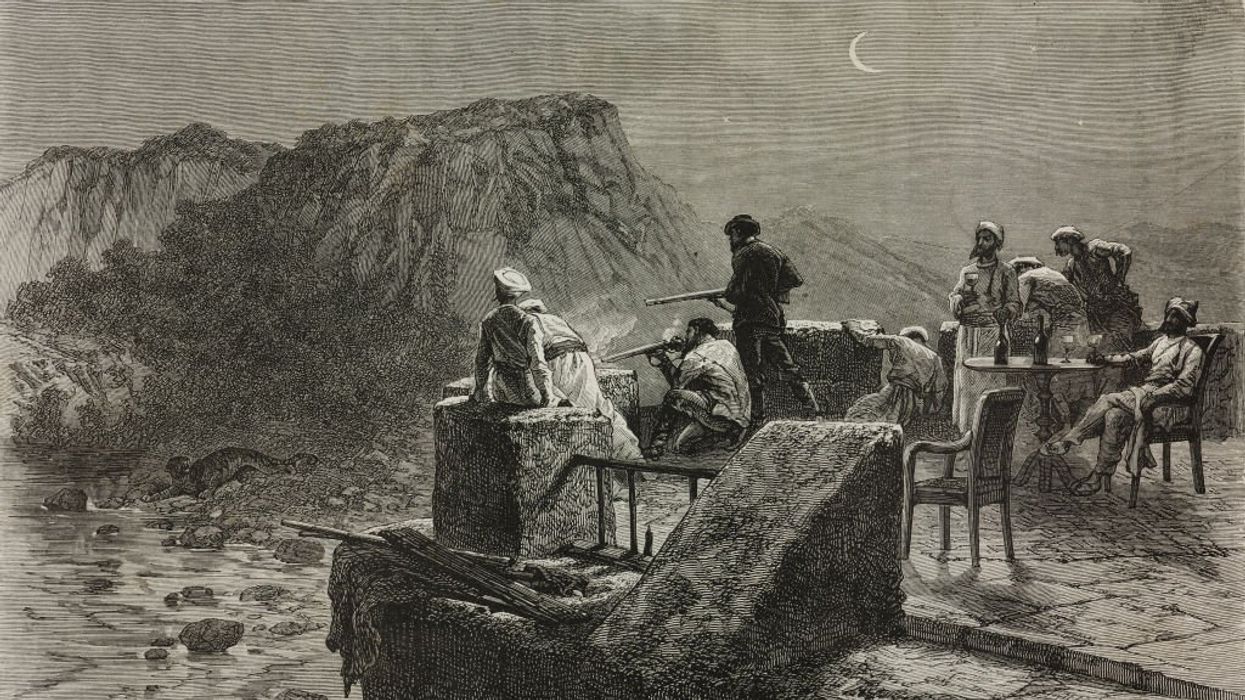
© 2024 Blaze Media LLC. All rights reserved.
Courageous 9/11 Firefighter Describes Miraculously Surviving the Twin Towers’ Collapse
September 11, 2011
"I didn't think I was going to live."

Lieutenant Joe Torrillo's story of bravery, courage and survival on September 11, 2001 is inspiring. Considering all he endured, though, it's a miracle that he lived to tell the tale of his terrifying experience.
On the morning of September 11th, 2001, Torrillo, then an active New York City firefighter, was planning to head to a press conference to address a new children's safety initiative he was involved in. But as we now know, the day took an unexpected turn that no one, including Torrillo, could have anticipated. He explains:
"The day, itself, was filled with a lot of irony. I was actually on my way to a press conference to introduce a new rescue hero -- a children's toy -- that I had helped design with Fisher Price."
Just before 9 o'clock a.m., the first plane hit the North Tower of the World Trade Center. While traveling into the city, Torrillo had a full view of the skyline. At that point, he says he could see "about nine floors of fire" beginning to engulf the building.
The veteran firefighter was more than familiar with the area that would come to be known as Ground Zero. He studied the Twin Towers as a college student and later spent part of his career working as a firefighter with Engine Company 10, located just feet from the Towers.
As he watched the building burn from afar, he couldn't help but think of his fellow firemen who were so close to the chaos.
At this point, many -- Torrillo included -- still assumed that this tragic occurrence was merely an accident. Having no solid information to go on, he decided to ditch the press conference and to head down to lower Manhattan to help. He explains:
"I made my way to my old firehouse, which didn't take long at all. I was there by 9 a.m. [After getting prepared] I ran out of the firehouse toward the North Tower. At 9:03, the second jet came right over my head and I watched it go through the South Tower."
At this point, everyone knew that something sinister was at play. Torrillo paints a very eery picture of the on-the-ground conditions:
"When I was there, believe it or not, other than the fire and the smoke, it was almost very desolated around the perimeter of the World Trade Center...it was almost like complete silence."
As Torrillo ran toward Ground Zero, his mind was filled with thoughts about the dangers ahead. But rather than worrying about his own safety, he was thinking about how to save others.
"As [I was] running toward the North Tower, hoping to get up to the upper levels, one of things [I was] saying to myself [was] that these buildings [were] going to collapse and that [I had] to let a lot of people know about it."
 Of course, there were many individuals who didn't believe that such a prospect was possible. Sure, the Towers had been attacked, but was it truly possible for the massive structures to come down?
Of course, there were many individuals who didn't believe that such a prospect was possible. Sure, the Towers had been attacked, but was it truly possible for the massive structures to come down?
"I started [telling people] and [they] started looking at me crosseyed wondering 'How the hell are two buildings going to collapse?,'" he explains.
Torrillo had extra insight, though, having studied structural engineering during his college years. One of his professors had worked on the World Trade Center. This educator, who managed the placement of concrete during the Towers' construction, brought Torrillo and his classmates to the buildings to analyze them in detail.
It was during this time -- years before the horrific terror attack -- that the brave firefighter says he learned that the Towers, though mighty in terms of their size, were flimsier than some of Manhattan's other skyscrapers.
"It was very obvious to me that those buildings were going to collapse...I was positive," he says. "My biggest fear was that we were going to lose a lot of people that day."
Torrillo told everyone, even other emergency workers who were trying to setup a triage, that they needed to get out. Again, he was met with resistance.
"They asked, 'Who are you? We don't work for you.' They were very hesitant. But I was adament about getting them out."
Luckily, they inevitably listened. Just as the last crew drove four or five blocks away he says he heard "a loud boom." He was outside, directly below the buildings.
"I looked up, and the building was starting to collapse. And I said to myself, 'You idiot -- you're the one who said this building's going to collapse and you put yourself right underneath it!'"
But Torrillo initially thought that it would take five or six hours for the Towers to buckle. At this point, only an hour or so had passed. With few options to ensure survival and with only seconds before he would be crushed under a monumental amount of steel and debris, there was little he could do.
 "I realized that I probably [was] not going to live. But I was afraid my body would never be found or identified. So I started running as fast as I could to try and make it under a footbridge," he says. "I figured if I can make it under that footbridge maybe they'd find my body."
"I realized that I probably [was] not going to live. But I was afraid my body would never be found or identified. So I started running as fast as I could to try and make it under a footbridge," he says. "I figured if I can make it under that footbridge maybe they'd find my body."
He never made it to the footbridge, though. There simply wasn't enough time for him to get there. What happened next is unimaginable.
"As I was running, the air pressure of the building lifted me off of my feet and blew me like a tornado."
Torrillo landed somewhere near the Marriott World Trade Center, a luxury hotel that was nestled between the two monstrous Towers. When the South Tower collapsed, it apparently split the hotel in half. Then, the majority of the Marriott came down and buried the firefighter alive. It was about 20 minutes later that rescuers found him alive under the rubble.
"I didn't think I was going to live. I had a very bad brain injury. A piece of steel had opened up the back of my head, all my ribs were broken, my arm was broken and I was bleeding internally."
Rescuers, desperately trying to get him to a hospital, transported him and put him on the back of a boat. "I remember hearing them say that I was going to die if they didn't get me to hospital," he recalls. But the horror didn't end there.
"At that point we heard another loud boom -- similar to the one we heard when the South Tower collapsed," he says. "It was the North Tower collapsing."
A huge portion of the North Tower flew across the street and landed on the boat. At that point, Torrillo miraculously mustered enough energy to jump into the boat's engine room, where he was buried under debris for a second time. It was 40 minutes later that rescuers, again, found him when they were attempting to start the boat back up.
The next thing he remembers, he was waking up in the trauma room of a hospital in Jersey City. What followed, he says, was a "long-term healing process." Between a traumatic head injury and a series of badly broken bones, moving forward wasn't easy.
"It took about four years before I was physically, mentally and psychologically feeling good," he says. Torrillo will be on medication for the rest of his life because of his brain injury.
When it comes to the 10-year anniversary, he says that it's a milestone or a benchmark, depending on who one is speaking with. He looks forward to seeing in the next couple of years what lower Manhattan will look like, as construction at the site is finally underway. But regardless of what happens, he says:
"There'll always be that sadness and wonder about how we were able to come out from under this."
While many questions about the future still remain, Torrillo has spent the past decade speaking to children, families and communities about the trauma he endured, his bravery and the many lessons he has learned from that tragic day.
He has officially retired from the New York Fire Department, although he still stays actively involved and engaged in issues pertaining to both the department and the September 11th attacks.
I have had the privilege of working with him since 2003 when we both participated in the annual youth-focused Peace Project event at the College of Mount Saint Vincent in New York City.
His amazing story has both inspired and educated audiences of all ages. His courage and the bravery of others like him should never be forgotten. Truly, his story is a profound lesson in selflessness.
Full Disclosure: Billy Hallowell and Lt. Joe Torrillo have traveled and spoken together at various venues since 2003.
Want to leave a tip?
We answer to you. Help keep our content free of advertisers and big tech censorship by leaving a tip today.
Want to join the conversation?
Already a subscriber?
Billy Hallowell is a digital TV host and interviewer for Faithwire and CBN News and the co-host of CBN’s "Quick Start Podcast."
Billy Hallowell
Billy Hallowell is a digital TV host and interviewer for Faithwire and CBN News and the co-host of CBN’s "Quick Start Podcast."
more stories
Sign up for the Blaze newsletter
By signing up, you agree to our Privacy Policy and Terms of Use, and agree to receive content that may sometimes include advertisements. You may opt out at any time.
© 2024 Blaze Media LLC. All rights reserved.
Get the stories that matter most delivered directly to your inbox.
By signing up, you agree to our Privacy Policy and Terms of Use, and agree to receive content that may sometimes include advertisements. You may opt out at any time.


